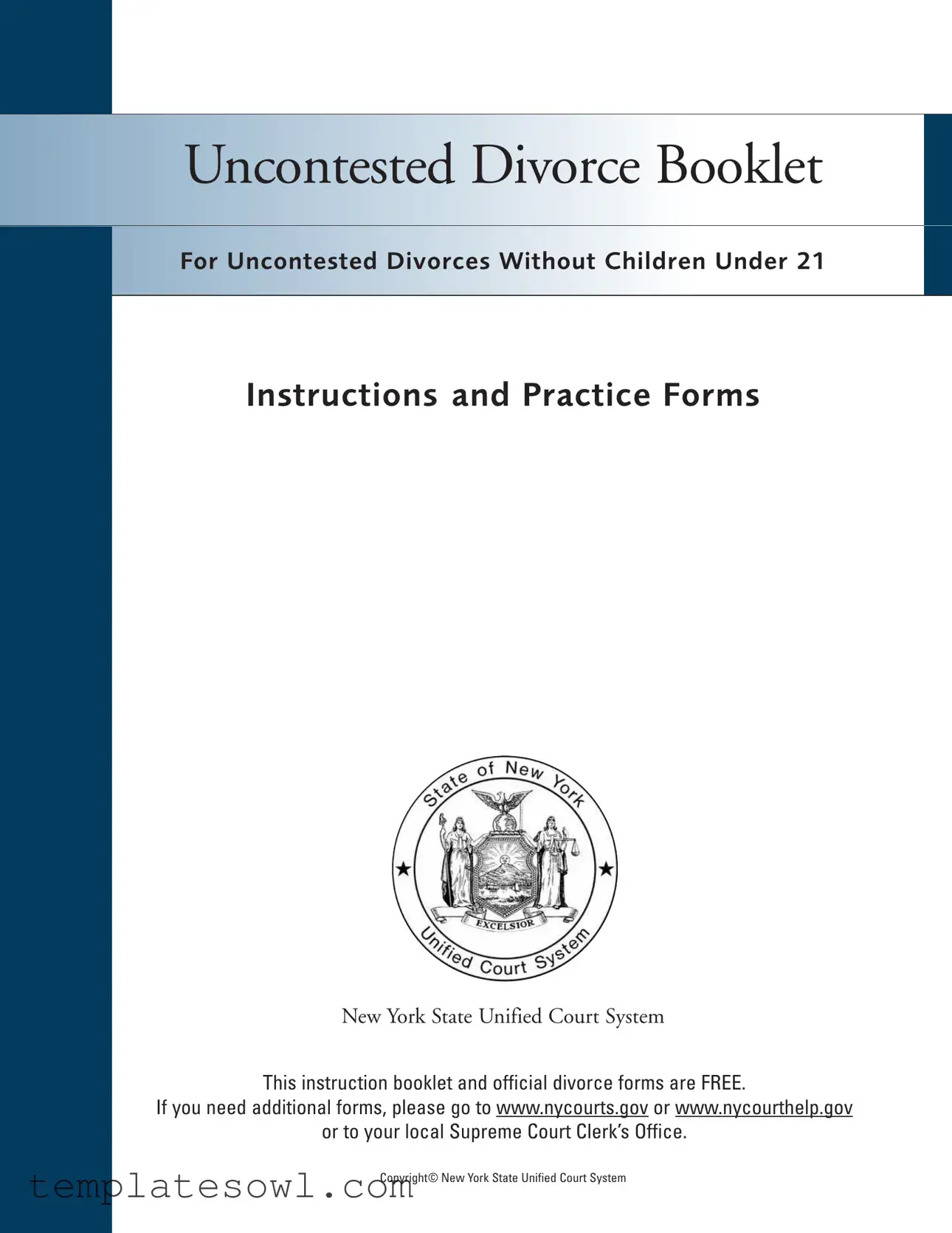Copyright© New York State Unified Court System
Uncontested Divorce Booklet
FOR UNCONTESTED DIVORCES WITHOUT CHILDREN UNDER 21
INSTRUCTIONS AND PRACTICE FORMS
New York State Unified Court System
Copyright© New York State Unified Court System
A lawyer can help you think through these and other important issues and take the legal steps to get you what you want. We strongly suggest that you give serious thought to using a lawyer for your divorce.
If you are unsure how to find a lawyer, these resources can help you find one:
•Go to www.lawhelp.ORG/ny if you cannot afford a lawyer;
•Call the New York State Bar Association Lawyer Referral Service (toll free) at 1-800-342-3661;
•Go to www.nycourthelp.gov and click on “Lawyers”;
•Go to www.nycourts.gov/attorneys/nybarassociations.shtml;
•Ask at any courthouse about lawyer referral services.
In this booklet you will find the main court forms needed for getting a divorce; help with filling out the forms; and instructions for doing the other things you will need to do to get your divorce.
The booklet has two parts — this Instructions Section and a Practice Forms Set.
If you are using the booklet, you should already have a set of Official Forms for your divorce case that were given to you with the booklet or that you obtained earlier. For each divorce form, please use the instructions to fill out a Practice Form first. When you are satisfied that the Practice Form is correct, copy your answers to the Official Form.
If you do not yet have a set of Official Forms, you can get them free at your county’s Supreme Court or by downloading them from www.nycourthelp.gov or www.nycourts.gov/forms/index.shtml.
If you have decided not to use a lawyer and to continue with this booklet, please read and completely finish only one step at a time. Reading ahead or going out of order can be confusing.
Ready to start? Please go to Step One.

Steps One through Five are about starting your divorce.
In these steps you will find out if New York State law allows your divorce at this time and, if so, how to fill out the papers that start the divorce and get them to your spouse.
In Step One you will answer several questions to see if you can start a New York State divorce case.
How old are you?
If you are at least 18, you can continue with this booklet.
If you are under 18, do not continue with this booklet. Talk with a lawyer about your situation.
Can you answer “Yes” to at least one of the following three questions?
1)Are you or your spouse now living in New York State, and have you lived in New York State for the last two years?
2)Are you or your spouse now living in New York State, have you lived in New York State for the last year, and is at least one of the following also true?
•your marriage ceremony was performed in New York State; or
•you lived in New York State with your spouse as husband and wife; or
•the “grounds” for your divorce happened in New York (“grounds” means a legal reason for divorce).
1
3)Do you and your spouse currently live in New York State (no matter how long) and your grounds for divorce happened in New York?
If you answered “Yes” to any one of those three questions, you may continue with this booklet.
If you could not answer “Yes” to any one of those three questions, you cannot start a New York State divorce at this time. Do not continue with this booklet. Talk with a lawyer about your situation.
Do you have grounds for divorce?
Next you will read about the six New York State divorce grounds. (Remember that “grounds” means a legal reason for divorce.)
After reading, if you believe you have at least one of these six grounds for divorce, continue with this booklet.
If you are not sure, do not continue with the booklet. Talk with a lawyer about your situation.
8
Ground #1: Abandonment
Please answer the following three questions:
•Did your spouse move out of the marital home at least one year ago and not move back – without any good reason and without your agreeing to it?
•Even if your spouse is still living in the marital home, has your spouse refused to have sexual relations with you for at least one year, without good reason and without you agreeing to it, even though you have continued to ask your spouse to have sexual
relations with you?
•Has your spouse refused to let you into the marital home for at least one year, without good reason and without you agreeing to it, even though you have continued to ask your spouse to let you into the home?
If you answered “Yes” to any one of the three questions , you can ask for a New York State divorce on the Abandonment ground.













 Uncontested
Uncontested Divorce
Divorce Booklet
Booklet







